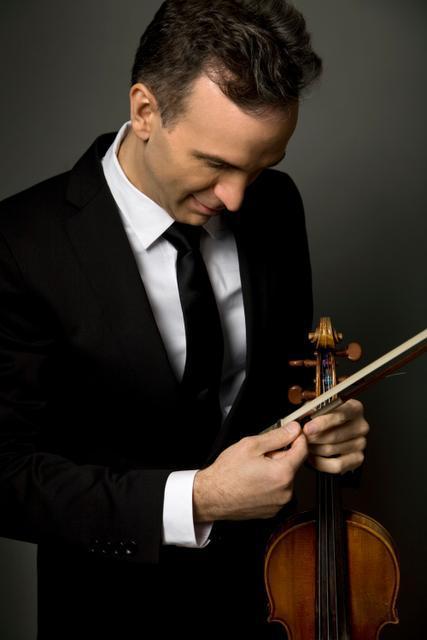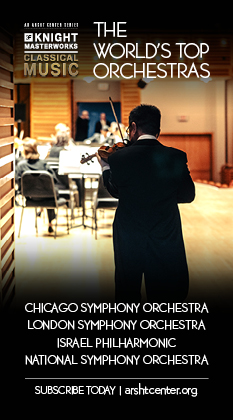Shaham’s concerto performance golden with Cleveland Orchestra

Gil Shaham performed Korngold’s Violin Concerto Friday night with the Cleveland Orchestra at the Arsht Center in Miami.
A concert devoted to the music of Vienna could take in a wide range of styles, from the turbulent drama of Beethoven or Brahms to the dour atonality of Arnold Schönberg.
The Cleveland Orchestra, under music director Franz Welser-Möst, took a light approach at its concert Friday at the Arsht Center in Miami, with a heart-on-the-sleeve violin concerto, a selection of waltzes and polkas and an early Schubert symphony.
Certain concertos fit a soloist’s style and technique perfectly, and so it appeared with Gil Shaham and the Korngold Violin Concerto. Although born in Hungary, Erich Wolfgang Korngold grew up in Vienna, and as the prospects for Jews in Austria darkened in the late 1930s, moved to Los Angeles and became a composer for Warner Brothers.
His Violin Concerto, which was drawn from some of his film scores, is his most popular concert work—late Romantic in tone, but with harmonic and rhythmic touches that could only be from the 20th century.
The work opens with a soaring, highly original melody, and Shaham made the most of it, taking it slowly enough to luxuriate in its lyricism and sliding from one note to the other with a touch of 1930s studio orchestra style. When it comes to broad flowing melodies, few violinists today could top him. His silken bowing was as seamless as could be, so smooth that it was like a soprano taking a long phrase in a single breath.
While primarily a melodic work, the concerto contains enough fireworks to allow the violinist to show off, and Shaham made the most of these, zipping with style through the quick notes that end the first movement. In the second movement, his performance of the opening melody was restrained, allowing him to deepen and broaden his tone effectively as the melody moved to the lower strings.
The Cleveland Orchestra, a fine partner throughout, brought a glowing tone to the movement’s mysterious harmonies. In the last movement, Shaham brought a bigness of tone and a pointed articulation to the rush of notes, giving the movement an exciting, energetic performance. And more than that, he seemed to be having a good time, smiling as he played through a particularly soaring passage and leaning in to listen to the orchestra.
Schubert’s Symphony No. 2, written as the composer turned 18, resembles the early Beethoven symphonies in style, but with turns of phrase that were unmistakably Schubert. Welser-Möst led a performance that was of distinctly Classical proportions – light, quick and with tempos that moved with the unwavering precision of a clock.
The first movement was a real workout for the violins, with endless streams of fast notes that moved with inimitable Schubert energy. Welser-Möst kept the volume way down, so the rushes of notes were almost like a whisper at times, and few orchestras could have brought this off with the clarity and precision of the Cleveland ensemble.
The second movement, a theme and variations, was taken at a brisk pace, with the orchestra growing softer and softer until a dark variation burst out. But even when the symphony growled, as in the aggressive minor-key opening of the third movement, which other conductors perform with more bite, it didn’t growl too loudly. The last movement proceeded with more light quick playing, with the symphony’s energy emerging through clean textures and well-shaped phrases rather than volume.
The second half was like an old-fashioned pops concert, where the orchestra plays light classics rather than, say, the theme from Batman Forever. Nearly all the music was by Johann Strauss Jr., with one work by his lesser-known brother Josef. The sound was glossy, the phrasing elegant in the Alpine melodies of Johann Strauss Jr.’s From the Mountains, the “Kiss” Waltz, and the overture to Die Fledermaus and his brother’s Polka-Mazurka from The Dragonfly. The orchestra also gave a vigorous account of the Hungarian-style melodies of the Czárdás from the opera Ritter Pázmán.
While the Cleveland ensemble played at top form throughout, there was an unvaried sameness to the second half, and so many of these light pieces coming one after the other gave the effect of being entertained by the world’s most expensive garden-party orchestra.
The program will be repeated 8 p.m. Saturday at the Arsht Center’s Knight Concert Hall and 8 p.m. Monday at the Philharmonic Center for the Arts in Naples. arshtcenter.org, 305-949-6722; artsnaples.org, 800-597-1900
Posted in Performances
3 Responses to “Shaham’s concerto performance golden with Cleveland Orchestra”
Leave a Comment
Sat Jan 25, 2014
at 11:11 am
3 Comments




Posted Jan 25, 2014 at 11:20 am by Jeremy
Shaham was remarkable as usual, the rest boring and perfunctory… Vienna is much more than that.
Posted Jan 26, 2014 at 12:08 pm by Jung
I agree. Wonderful first half. The rest was pablum for the cross-over crowd. Vienna? Home of the anti-Semitic dour. I don’t salute it/them.
Posted Jan 30, 2014 at 11:55 am by Kathrin Korngold Hubbard
To the critic who wrote the above review, I would respectfully submit that my grandfather was born in Brno, part of the Austro-Hungarian Empire, and now the Czech Republic in 1897.